Last.fm Limited is a music website founded in the United Kingdom in 2002. Using a music recommender system called "Audioscrobbler", Last.fm builds a detailed profile of each user's musical taste by recording details of the tracks the user listens to, either from Internet radio stations, or the user's computer or many portable music devices. This information is transferred ("scrobbled") to Last.fm's database either via the music player or via a plug-in installed into the user's music player. The data is then displayed on the user's profile page and compiled to create reference pages for individual artists.
AOL Radio powered by Slacker was an online radio service available in the United States only. It had over 200 free internet radio stations.
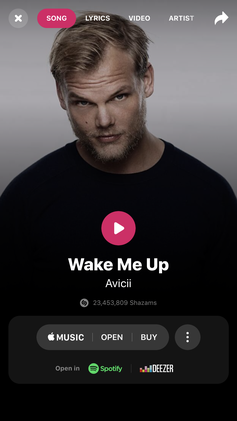
Shazam is an application that can identify music based on a short sample played using the microphone on the device. It was created by London-based Shazam Entertainment, and has been owned by Apple Inc. since 2018. The software is available for Android, macOS, iOS, Wear OS, watchOS and as a Google Chrome extension.
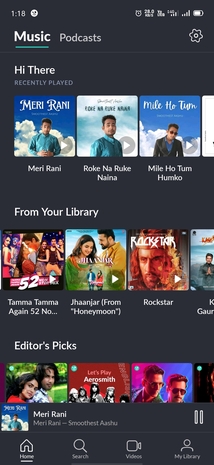
JioSaavn is an Indian Music streaming service and a digital distributor of Hindi, Marathi, English, Malayalam, Bengali, Kannada, Tamil, Telugu, Bhojpuri, Punjabi, Chhattisgarhi and other regional languages of India. Since it was founded in 2007 as Saavn, the company has acquired rights to over 80 million music tracks in 16 languages. JioSaavn is a freemium service; basic features are free with advertisements or limitations, while additional features, such as improved streaming quality and music downloads for offline listening, are offered via paid subscriptions.

Here Technologies is a Dutch multinational group specialized in mapping technologies, location data and related automotive services to individuals and companies. It is majority-owned by a consortium of German automotive companies and American semiconductor company Intel whilst other companies also own minority stakes. Its roots date back to U.S.-based Navteq in 1985, which was acquired by Finland-based Nokia in 2007. Here is currently based in The Netherlands.
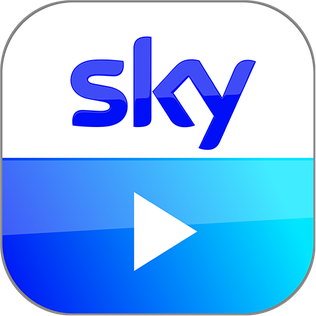
Sky Go is a streaming television service from Sky Group provided free for Sky TV subscribers in the United Kingdom and Ireland. It complements Sky TV by allowing subscribers to watch live and on demand Sky TV via an internet connection on the go. The Sky Go app is available on Windows and Mac computers and also on Android and iOS devices.
Spotify is a Swedish audio streaming and media services provider founded on 23 April 2006 by Daniel Ek and Martin Lorentzon. It is one of the largest music streaming service providers, with over 590 million monthly active users, including 226 million paying subscribers, as of September 2023. Spotify is listed on the New York Stock Exchange in the form of American depositary receipts.
Blinkbox Music was a free, advertising supported, music streaming service, with over 12 million tracks available for streaming in the UK and Ireland, with content from the music industry, and most independent labels and distributors.

MixRadio was an online music streaming service owned by Line Corporation. The service was first introduced by Nokia in 2011 as Nokia Music for Windows Phone, serving as a successor to Nokia's previous Nokia Music Store/Comes with Music/Ovi Music Store initiatives, which was based on the LoudEye/OD2 platform. After its acquisition of Nokia's mobile phone business, the service was briefly maintained by Microsoft Mobile Oy before it was sold to Japanese internet company Line Corporation in 2015. Following the acquisition, MixRadio expanded to Android and iOS in May 2015.
A mobile application or app is a computer program or software application designed to run on a mobile device such as a phone, tablet, or watch. Mobile applications often stand in contrast to desktop applications which are designed to run on desktop computers, and web applications which run in mobile web browsers rather than directly on the mobile device.
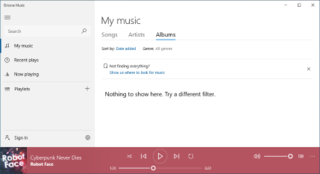
Groove Music is a discontinued audio player software application included with Windows 8, Windows 8.1, Windows 10 and Windows 11.
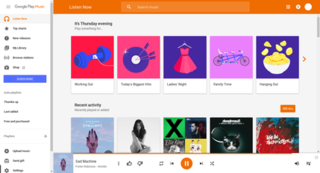
Google Play Music was a music and podcast streaming service and an online music locker operated by Google as part of its Google Play line of services. The service was announced on May 10, 2011; after a six-month, invitation-only beta period, it was publicly launched on November 16, 2011 and shut down in December 2020.
The following is a list of on-demand music streaming services. These services offer streaming of full-length content via the Internet as a part of their service, without the listener necessarily having to purchase a file for download. This type of service is somewhat similar to Internet radio. Many of these sites have advertising and offer non-free options in the style of a digital music store.
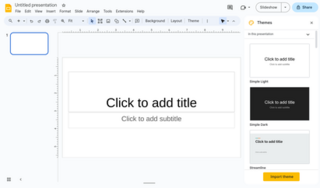
Google Slides is a presentation program included as part of the free, web-based Google Docs suite offered by Google. Google Slides is available as a web application, mobile app for: Android, iOS, and as a desktop application on Google's ChromeOS. The app is compatible with Microsoft PowerPoint file formats. The app allows users to create and edit files online while collaborating with other users in real-time. Edits are tracked by a user with a revision history presenting changes. An editor's position is highlighted with an editor-specific color and cursor and a permissions system regulates what users can do. Updates have introduced features using machine learning, including "Explore", offering and "tasks to other users.

Google Play Newsstand was a news aggregator and digital newsstand service by Google. On May 8, 2018, Google announced at Google I/O that Google Play Newsstand was being amalgamated with Google News. Launched in November 2013 through the merger of Google Play Magazines and Google Currents, the service let users subscribe to magazines and topical news feeds, receiving new issues and updates automatically. Content was offered for reading on a dedicated Newsstand section of the Google Play website or through the mobile apps for Android and iOS. Offline download and reading is supported on the mobile apps.
Google TV is a digital distribution service for movies and TV shows. It is operated by Google. Announced in September 2020, as a service it allows users to search and discover video titles available across multiple streaming services as well as to rent or to buy available titles from Google and add any selected title to a watchlist for watching or accessing such titles from eligible devices and platforms. The buy, rent or preorder options were also part of Google Play Movies & TV, another service by Google which later was moved to Google TV service.
SoundayMusic is a geosocial networking mobile music streaming app that enables users to listen to and track the music their friends and neighbors are playing in real time. The service provides over 32 million tracks and allows users to create "music stations" choosing between a mix of up to three artists, or choosing a music genre. In the free version users can create up to 10 personalized stations, look at the stations that are being played nearby in real time, and interact with other users through instant chat. The paid, premium subscription removes advertisements and allows users to create an unlimited number of stations. It was launched in 2009> by Soundtracker, and as of December 2014 the service had 1.3 million registered users. Soundtracker is available for iOS App Store, Android Google Play, Windows Phone Store, Windows Store, Google Glass, BlackBerry World, Samsung Apps, Amazon Appstore, Nook, and Samsung Smart TV, in 10 languages: English, Spanish, French, German, Portuguese, Italian, Chinese Simplified, Japanese, Korean and Russian. Soundtracker is a registered trademark.

Here WeGo is a web mapping and satellite navigation software, operated by HERE Technologies and available on the Web and mobile platforms. It is based on HERE's location data platform, providing its in-house data, which includes satellite views, traffic data, and other location services. Maps are updated every two or three months.

myTuner Radio, or simply myTuner, is an Internet radio app directory/platform owned by AppGeneration – Software Technologies, Lda, a development company based in Porto, Portugal founded by Eduardo Carqueja in October 2010. myTuner Radio has over 50,000 radio stations and one million podcasts from all around the world. On June 7, 2017, AppGeneration announced that its service had over 30 million users and a database with radio stations of 200 countries. my Turner Radio platform is available for the web at mytuner-radio.com, for a suite of mobile apps: iOS, Google Play, Samsung, Huawei, Amazon, Windows Phone; for desktop devices: Web, Windows, and Mac, wearables: Apple Watch and Android Wearables, for connected devices like Apple TV, Samsung TVs, LG TVs, TV sets and set-top boxes with Android TV, Amazon Fire TV, Roku TV and Chromecast, connected cars: Apple Carplay, Android Auto, Bosch mySPIN, Jaguar & Land Rover InControl Apps, and also on home appliances and smart speakers like Alexa and Sonos.










